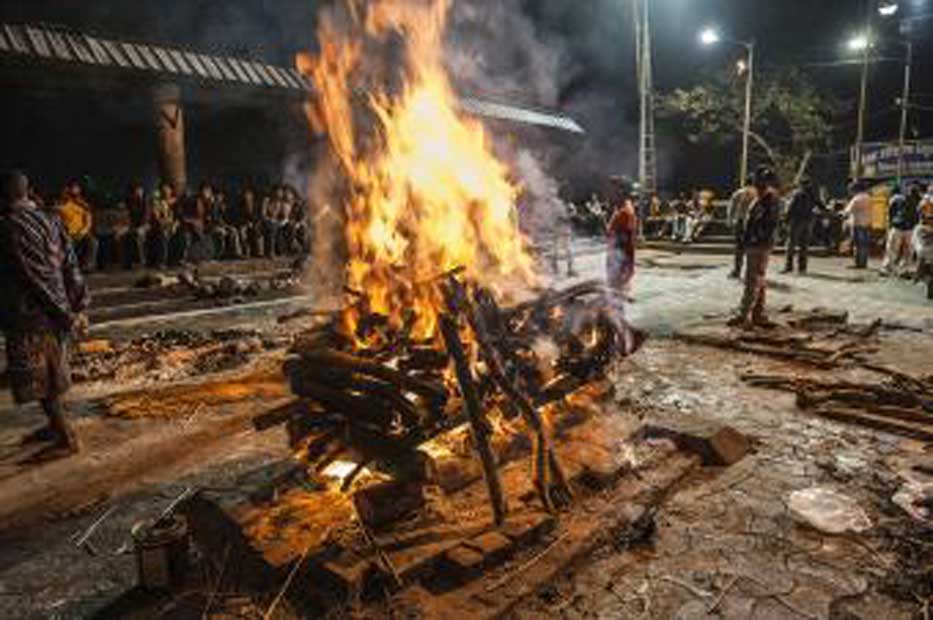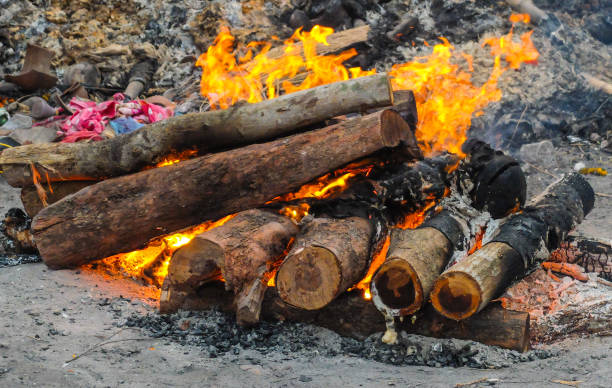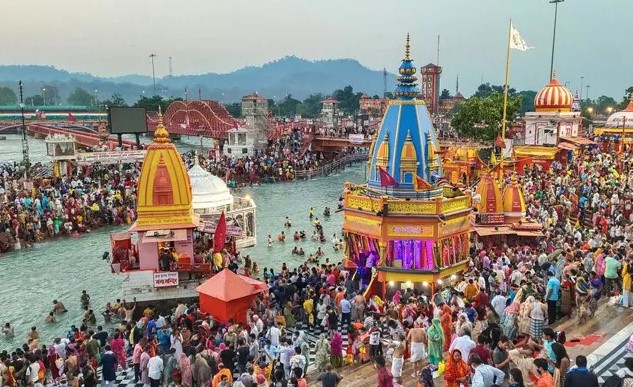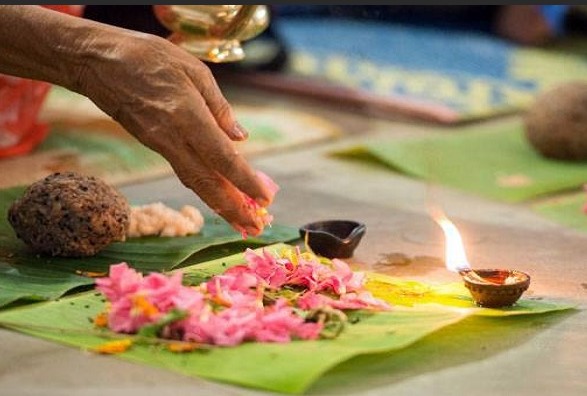Hindu Funeral Rituals : A funeral is the ceremony that is held when the body of someone who has died is buried or cremated. Hindus believe that life and death are part of the concept of sansara, or rebirth. The ultimate goal for many Hindus is to become free from desire, thereby escaping samsara and attaining moksha, the transcendent state of salvation.
- Inform friends and family by email, phone, or sending message by someone or whichever way you deem fit. In these days people are well connected with WhatsApp or social media Facebook.
- The family is not allowed to prepare meals for at least one day after the cremation, therefore, usually relatives or family friends bring prepared food to the home or people may get food from the market these days.
- It is ritual to wear white clothes or light color clothes on the death in the family.
- Preparing the Body for cremation – First the dead body is bathed. After bathing the deceased is covered with a white shroud. Ram’s name sheet is put on top of the shroud. After this, the dead body is bid farewell by wearing a garland made of flowers. If a married woman dies, her complete makeup is done before the last farewell. After doing all the makeup, the woman’s husband decorates vermilion for the last time in her demand. In this way, along with complete makeup, the married woman is sent on the last journey.
हिंदू अंतिम संस्कार की रस्में – अनुष्ठान विधि
- Before reaching the cremation ground, the family members circumambulate the body. After this the deceased is taken to the crematorium/ cremation ground. Even while taking the body towards the cremation ground, some special things are taken care of.
Like in the beginning, when the body is taken towards the crematorium,
the head is kept in the front and the feet in the back.
There is a provision to place the body on an altar after it has been taken away.
- The belief behind this is that by doing this the dead person can see the world for the last time. After this, when the body is raised, its direction is changed. Now the legs are turned forward and the head back. The belief behind this is that now the dead body’s bond with the world has been broken, and he is moving forward looking at the way to the cremation ground.
- After reaching the cremation ground, when the dead body is laid on the pyre, its head is always kept towards the south direction.
Hindu Funeral Rituals
- Before lighting the funeral pyre at the cremation ground, the person who is performing the funeral procession takes water in a pitcher with a hole and goes around the pyre.
After the completion of the parikrama, the pot is broken, it is a religious belief that by doing this process disillusionment can be removed from the dead body.
Along with this, it is also believed that by performing this ritual, all the elements of water, fire, sky and earth are involved in the process of funeral. Following all the rules, the pyre is lit in the last. - After the cremation of the deceased, there is a strict ritual in the house for 10 days. During this some other rules have to be followed along with the food.
- A water pot and lamp/diya are placed where the body was located.
The water is changed every day. An earthen lamp is lit on the precise spot.
हिंदू अंतिम संस्कार की रस्में – अनुष्ठान विधि
- The flame of this lamp is kept facing the south, since that is the direction of abode of the Deity of death, Yama.
- On the third day, the ash of the expired collected in a small pot is then scattered in the large water body like River Ganges.
The ash scattered in some other running water body not possible to visit Ganga. - On the tenth day after Shanti Karma, the process of Mundan Sanskar is done. It is mandatory for all the relatives of the deceased to have Mundan ceremony. Pind Daan is done on the 12th day.
- Preta-karma is a ceremony that often happens on the 13th day of mourning. The family performs rituals to release the soul to support reincarnation. On this day, Feast is organized on this day.
- After this process of 13 days, the soul of the deceased person goes on a journey to another world.
- Family members are not allowed to visit the temple till the 16th day mourning period is also not allowed to participate in marriages, observe festivals.
- On the 16th day, Mourning ends, the family visits a nearby temple on reports of priest’s command after that the family is allowed to participate in enthusiastic occasions.
Hindu Funeral Rituals – हिंदी में अनुष्ठान विधि
- ईमेल, फोन, या किसी के द्वारा संदेश भेजकर या जो भी आपको उचित लगे, मित्रों और परिवार को सूचित करें।
इन दिनों लोग व्हाट्सएप या सोशल मीडिया फेसबुक से अच्छी तरह जुड़े हुए हैं। - परिवार को दाह संस्कार के बाद कम से कम एक दिन के लिए भोजन तैयार करने की अनुमति नहीं है,
इसलिए आमतौर पर रिश्तेदार या परिवार के मित्र घर में तैयार भोजन लाते हैं - परिवार में मृत्यु होने पर सफेद या हल्के रंग के कपड़े पहनने की रस्म होती है।
- शरीर को दाह संस्कार के लिए तैयार करना सबसे पहले शव को नहलाया जाता है।
स्नान करने के बाद मृतक को सफेद कफन से ढक दिया जाता है।
कफन के ऊपर राम नाम का पत्रक लगाया जाता है।
इसके बाद फूलों की माला पहनाकर शव को विदा किया जाता है।
यदि किसी विवाहित महिला की मृत्यु हो जाती है तो अंतिम विदाई से पहले उसका पूरा श्रृंगार किया जाता है।
सारा मेकअप करने के बाद महिला का पति अपनी मांग में आखिरी बार सिंदूर सजाता है। - इस तरह पूरे श्रृंगार के साथ विवाहिता को अंतिम यात्रा पर भेजा जाता है।
- श्मशान घाट पहुंचने से पहले परिवार के सदस्य शव की परिक्रमा करते हैं।
इसके बाद मृतक को श्मशान/श्मशान घाट ले जाया जाता है।
शव को श्मशान घाट की ओर ले जाते समय भी कुछ खास बातों का ध्यान रखा जाता है।
जैसे शुरू में जब शरीर को श्मशान की ओर ले जाया जाता है तो सिर को आगे और पैरों को पीछे की ओर रखा जाता है।
शव को ले जाने के बाद वेदी पर रखने का प्रावधान है।
हिंदू अंतिम संस्कार की रस्में – अनुष्ठान विधि
- इसके पीछे मान्यता यह है कि ऐसा करने से मृत व्यक्ति दुनिया को आखिरी बार देख सकता है।
इसके बाद जब शरीर को ऊपर उठाया जाता है तो उसकी दिशा बदल जाती है।
अब पैर आगे की ओर और सिर पीछे की ओर कर दिया गया है।
इसके पीछे की मान्यता यह है कि अब शव का संसार से बंधन टूट चुका है और वह श्मशान घाट का रास्ता देखते हुए आगे बढ़ रहा है। - श्मशान घाट पर पहुंचने के बाद जब शव को चिता पर रखा जाता है तो उसका सिर हमेशा दक्षिण दिशा की ओर रखा जाता है।
श्मशान घाट पर चिता जलाने से पहले अंतिम संस्कार करने वाला व्यक्ति एक छेद वाले घड़े में पानी लेकर चिता के चारों ओर जाता है।
परिक्रमा पूरी होने के बाद घड़े को तोड़ा जाता है, यह एक धार्मिक मान्यता है कि इस प्रक्रिया को करने से मृत शरीर से मोह को दूर किया जा सकता है। इसके साथ ही यह भी माना जाता है कि इस अनुष्ठान को करने से जल, अग्नि, आकाश और पृथ्वी के सभी तत्व अंतिम संस्कार की प्रक्रिया में शामिल होते हैं। सभी नियमों का पालन करते हुए अंतिम में चिता को जलाया जाता है।
Hindu Funeral Rites – हिंदी में अनुष्ठान विधि
- मृतक के दाह संस्कार के बाद 10 दिनों तक घर में कठोर अनुष्ठान होता है।
इस दौरान खाने के साथ-साथ और भी कई नियमों का पालन करना होता है।
जहां शव था वहां पानी का बर्तन और दीपक/दीया रखा जाता है।
पानी रोज बदला जाता है। सही जगह पर मिट्टी का दीपक जलाया जाता है।
इस दीपक की लौ दक्षिण की ओर मुख करके रखी जाती है, क्योंकि यह मृत्यु के देवता यम के निवास की दिशा है। - तीसरे दिन, एक छोटे से बर्तन में एकत्र की गई राख की राख को गंगा नदी जैसे बड़े जल निकाय में बिखेर दिया जाता है।
किसी अन्य बहते जलस्रोत में बिखरी राख का गंगा के दर्शन करना संभव नहीं है। - शांति कर्म के दसवें दिन मुंडन संस्कार की प्रक्रिया की जाती है। मृतक के सभी परिजनों के लिए मुंडन संस्कार होना अनिवार्य है।
- पिंडदान की प्रक्रिया 12वें दिन की जाती है।
- प्रेत-कर्म एक समारोह है जो अक्सर शोक के 13वें दिन होता है।
परिवार पुनर्जन्म का समर्थन करने के लिए आत्मा को मुक्त करने के लिए अनुष्ठान करता है।
इसके बाद 13वें दिन मृत्यु भोज का आयोजन किया जाता है।
इस तरह 13 दिनों की इस प्रक्रिया के बाद मृत व्यक्ति की आत्मा दूसरी दुनिया की यात्रा पर निकल जाती है। - परिवार को 16वें दिन तक मंदिर जाने की अनुमति नहीं है, शोक की अवधि भी शादियों में भाग लेने की अनुमति नहीं है, त्योहारों का पालन करें। शोक की अवधि के 16वें दिन, परिवार को उत्साही अवसरों में भाग लेने की अनुमति मिलने के बाद, पुजारी की आज्ञा की रिपोर्ट पर परिवार पास के एक मंदिर में जाता है।




